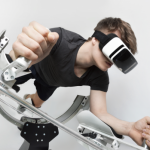 Phantom body pain is a serious issue for paraplegics, and can cause a high level of discomfort. An interesting new Swiss project has utilized virtual reality to help reduce this pain. The project, which was documented in a recently published paper, creates a bodily illusion in VR to trick the mind into dulling their pain.
Phantom body pain is a serious issue for paraplegics, and can cause a high level of discomfort. An interesting new Swiss project has utilized virtual reality to help reduce this pain. The project, which was documented in a recently published paper, creates a bodily illusion in VR to trick the mind into dulling their pain.
“We managed to provoke an illusion: the illusion that the subject’s legs were being lightly tapped, when in fact the subject was actually being tapped on the back, above the spinal cord lesion,” the researchers say. “When we did this, the subjects also reported that their pain had diminished.”
Reducing pain
Whilst paraplegics cannot feel their legs, they often suffer from neuropathic pain due to the lesion of the spinal cord. This gives them pain in the legs, despite no other feeling originating from them. Not only is the pain very real, but it’s also resistant to drug therapy. The researchers hope that virtual reality can provide a more effective method of pain relief via an approach common with the restoration of the sense of touch.
“We tapped the back of the subject near the shoulders and the subject experienced the illusion that the tapping originated from the paralyzed legs,” the researchers explain. “This is because the subject also received visual stimuli of dummy legs being tapped, viewed through the virtual reality headset, so the subject saw them immersively as his or her own legs.”
Participants were placed in an experimental environment, complete with dummy legs, a camera, VR goggles and a pair of rods. The legs were filmed with the camera, with the real-time footage streamed into the VR goggles worn by the participant. The legs are viewed from above, as though you were looking at your own legs. After a period of time, the researchers would tap the patient’s back with one of the rods, and the dummy legs with the other.
As such, each participant receives a couple of stimuli, a tactile one on their back and a visual one via their VR display. The participants reported being consciously aware of being tapped on the back, but also feeling like the tapping was coming from their paralyzed legs.
“It takes about a minutes of simultaneously tapping for the illusion to take place,” the researchers say. “The tapping on the back gets translated onto the legs because the visual stimulus dominates over the tactile one.”
The ultimate aim of the project is to manipulate the brain for therapeutic uses. For instance, the team are working on a second VR-based project to automate visuo-tactile stimulations for people with spinal cord injuries. The hope is that the technology will be suitable for regular use at home.